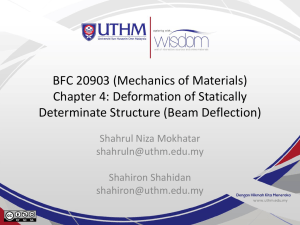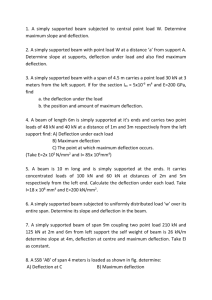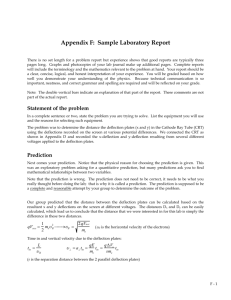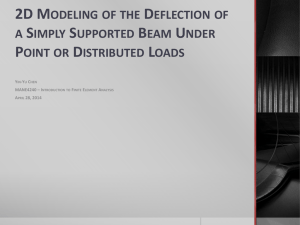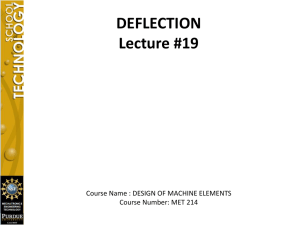Lecture 28
advertisement
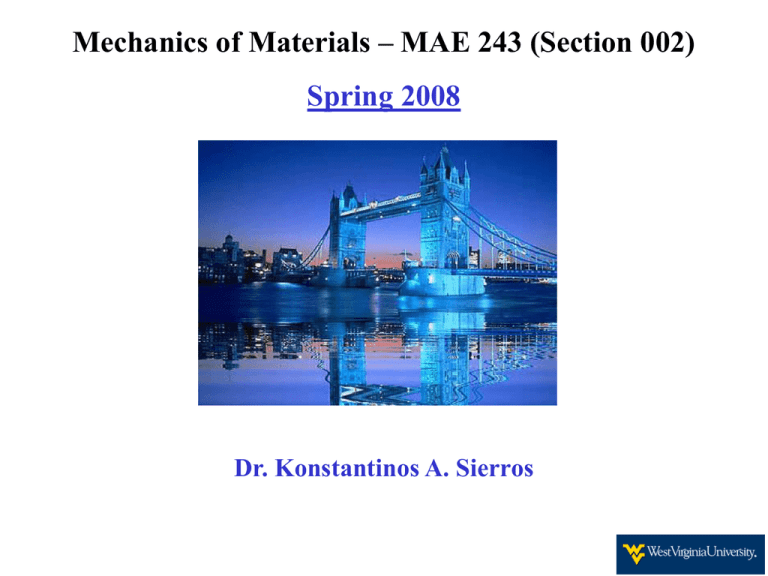
Mechanics of Materials – MAE 243 (Section 002) Spring 2008 Dr. Konstantinos A. Sierros Chapter 9: Deflection of beams • When a beam with a straight longitudinal axis is loaded by lateral forces, the axis is deformed into a curve, called the deflection curve of the beam • In Chapter 5 we used the curvature of the bent beam to determine the normal strains and stresses in the beam • But we did not develop a method for finding the deflection curve itself • In this Chapter we will determine the equation of the deflection curve and we will also find the deflections at specific points along the axis of the beam • Applications include the analysis of aircraft vibrations and the analysis of the response of buildings to earthquakes 9.2: Differential equations of the deflection curve • Most procedures for finding beam deflections are based on the differential equations of the deflection curve and their associated deflections • The deflection v is the displacement in the in the y direction of any point on the axis of the beam. We assume that all loads act in this plane (the plane of bending) • In order to obtain the equation of the deflection curve we must express v as a function of the coordinate x FIG. 9-1 Deflection curve of a cantilever beam Copyright 2005 by Nelson, a division of Thomson Canada Limited 9.2: Differential equations of the deflection curve • When the beam is bent, there is not only a deflection at each point along the axis but also rotation • The angle of rotation θ of the axis of the beam is the angle between the x axis and the tangent to the deflection curve as shown in fig 9-2b FIG. 9-2 Deflection curve of a beam Copyright 2005 by Nelson, a division of Thomson Canada Limited 9.2: Differential equations of the deflection curve • The curvature k is given by the following equation radius of curvature • The sign convention for curvature is shown in fig 9-3 • The slope of the deflection curve is the first derivative dv/dx of the expression for the deflection v FIG. 9-3 Sign convention for curvature Copyright 2005 by Nelson, a division of Thomson Canada Limited 9.2: Differential equations of the deflection curve • Beams with small angles of rotation • The structures encountered in everyday life, such as buildings, automobiles, aircraft, ships undergo relatively small changes in shape while in service. Therefore, we have small angles of rotation and very small deflections Differential equation of the deflection curve Sign conventions for bending moment M, shear force V, and intensity q of distributed load FIG. 9-4 M is bending moment Copyright 2005 by Nelson, a division of Thomson Canada Limited EI is flexural rigidity 9.2: Differential equations of the deflection curve • Prismatic beams BENDING – MOMENT EQUATION SHEAR – FORCE EQUATION LOAD EQUATION 9.2: Deflection by integration of the bending – moment equation Procedure for solving the differential equations of the deflection curve 1. For each region of the beam, we substitute the expression for M into the differential equation and integrate to obtain the slope v’ 2. Each such integration produces one constant of integration 3. Next we integrate each slope equation to obtain the corresponding deflection v 4. Again each integration produces a new constant 5. Thus, there are two constants of integration for each region of the beam 6. These constants are evaluated from known conditions pertaining to the slopes and deflections 9.2:Conditions 1. Boundary conditions pertain to the deflections and slopes at the supports of the beam. 2. At a simple support the deflection is zero 3. At a fixed support both the deflection and the sloe are zero 4. Each such boundary condition supplies one equation that can be used to evaluate the constants of integration FIG. 9-6 FIG. 9-5 Boundary conditions at simple supports Copyright 2005 by Nelson, a division of Thomson Canada Limited Boundary conditions at a fixed support Copyright 2005 by Nelson, a division of Thomson Canada Limited 9.2:Conditions 1. Continuity conditions occur at points where the regions of integration meet, such as at point C in the beam of the figure below 2. The deflection curve of the beam is physically continuous at point C and therefore the deflection at point C as determined from the left hand part of the beam must be equal to the deflection at point C as determined for the right-hand part 3. Similarly the slopes found for each part of the beam must be equal at point C 4. Each of these continuity conditions supplies an equation for evaluating the constants of integration FIG. 9-7 Continuity conditions at point C Copyright 2005 by Nelson, a division of Thomson Canada Limited Have a nice weekend
